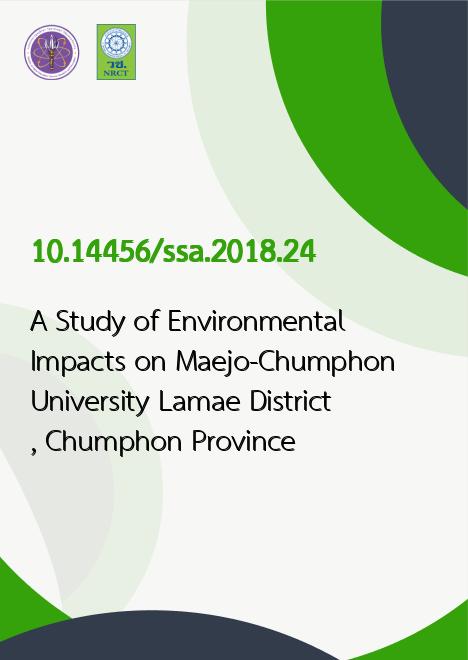
|
A Study of Environmental Impacts on Maejo-Chumphon University Lamae District, Chumphon Province |
|---|---|
| รหัสดีโอไอ | |
| Creator | Benjamas Na Thongkaew |
| Title | A Study of Environmental Impacts on Maejo-Chumphon University Lamae District, Chumphon Province |
| Contributor | Amnat Ruksapol, Uthaiwan Sriwichai, Jutamas Phengkona |
| Publisher | National Research Council of Thailand |
| Publication Year | 2561 |
| Journal Title | SOCIAL SCIENCE ASIA : Official Journal of National Research Council of Thailand in conjunction with Maejo University |
| Journal Vol. | 4 |
| Journal No. | 3 |
| Page no. | 77-88 |
| Keyword | Environmental Impacts, Maejo-Chumphon University |
| URL Website | http://e-journal.nrct.go.th/ |
| Website title | e-journal |
| ISSN | 2229-2608 |
| Abstract | This study employed survey research to collect data on environmental impacts comprising electrical energy, garbages, water, and green areas arised from teaching and learning facilitation and managerial administration in Maejo University, Chumpon campus. Interview was conducted with executives of the university and a set of questionnaires was used for data collection administered with staff and personnel of the university. Obtained data were analyzed by using descriptive statistics and the statistical package. Results of this study revealed four issues including: 1) there were no clear regulations of waste management which contradict to the image of the green university as claimed; 2) water quality met the required standards. However, it could not be used for drinking because it was from rainwater and groundwater; 3) the green areas in the university were found that the land was composed of sandy soil which was suitable for Queen' s flower (Lagerstroemia speciose) and Kra thin saba ( Acacia mangium wilds) because Queen' s flower was a symbol of the university, and it could be grown in the local environment; 4) the electricity consumption in the university in 2016 was less than in 2015. In addition, inappropriate behaviors of electricity using included leaving classrooms and student dormitories without turning off the lights and electric fans and keeping air conditioners turning on in the offices where there was no one in the office. The practical solution dealing with environmental impacts is to actively establish cooperation between every section on the university campus in order to lead the university to the Green University as expected. In addition, campaigns provoking environmental awareness regarding waste management and energy saving should be held regularly. Green zoning and water management should also be initiated. |